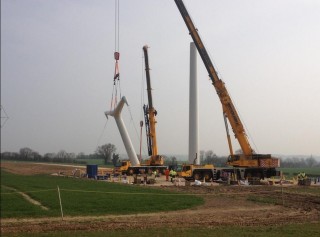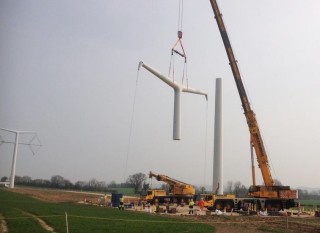The ground works, foundations and erection of the T-pylon at Eakring have been carried out by Balfour Beatty. Steel manufacturer Mabey Bridge produced the monopole and T cross section of the T-pylons as well as doing the final painting of the structure at its factory in South Wales.
The T-pylon was the winner of an international design competition to look for a 21st century design to carry high voltage overhead lines. The winning design from Bystrup, the Danish architects and engineering company, is 35 metres high – up to one third lower than the conventional steel lattice pylon.
[See our previous reports here, here, and here.]
A span of six of the new T-pylons will be built, with each designed to perform a different function on the transmission network:

- The standard suspension pylon that is designed to carry the cables in a straight line. Two suspension pylons will be built at Eakring
- A D30 pylon which can allow for the greater pressure and weight of turning the cables at an angle of up to 30 degrees
- An F10 flying angle suspension pylon which can allow a turn of up to 10 degrees – the first time such a pylon has been used in the UK
- A pair of terminal diamond pylons which end a line at a substation or take the cables underground
- A gantry terminal which is an alternative design of terminal pylon with the same function as the diamond terminal pylon.
Since the design competition in 2011, National Grid has worked with other engineers and partners to turn the design into reality and make sure the design could cope with all the stresses placed on a pylon.
David Wright, director of electricity transmission asset management at National Grid said: “We’ve been able to answer yes to the hundreds questions that need to be asked before we can introduce a new type of pylon. The training line has enabled us to learn so many lessons about how to manufacture and build the T-pylon. I’m incredibly proud of the high standard of engineering that brought us to this point.
“We developed the new style of pylon so that we could have a 21st century design to offer as we plan new transmission routes. The T-pylon is not a replacement for the steel lattice pylon but it’s a new option and in some landscapes its shorter height and sleeker appearance can offer real advantages.”
Got a story? Email news@theconstructionindex.co.uk




